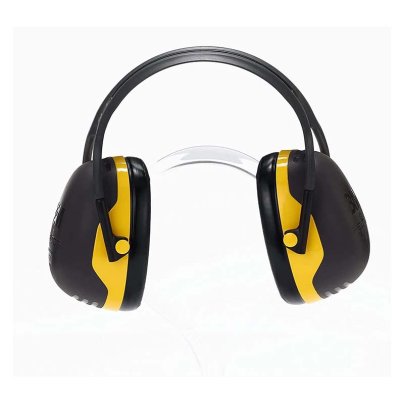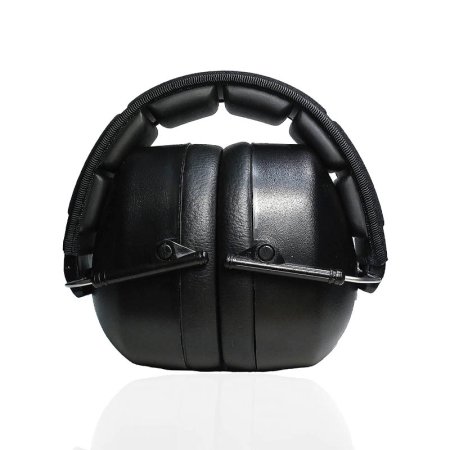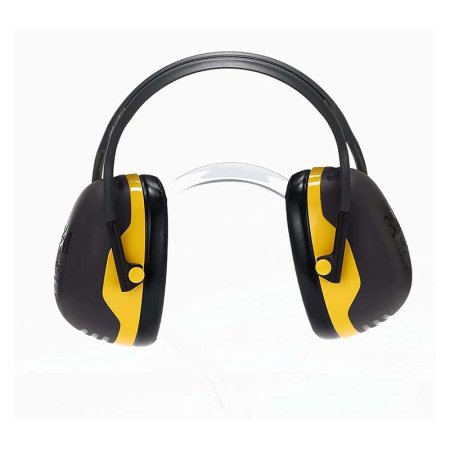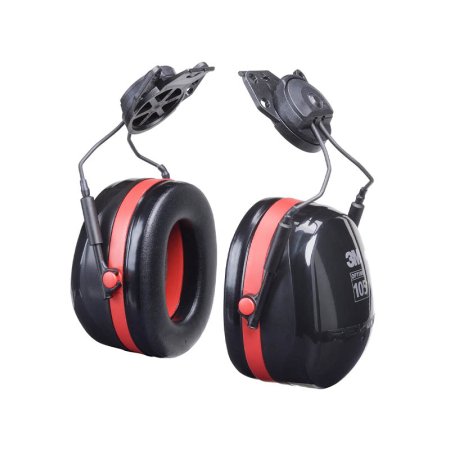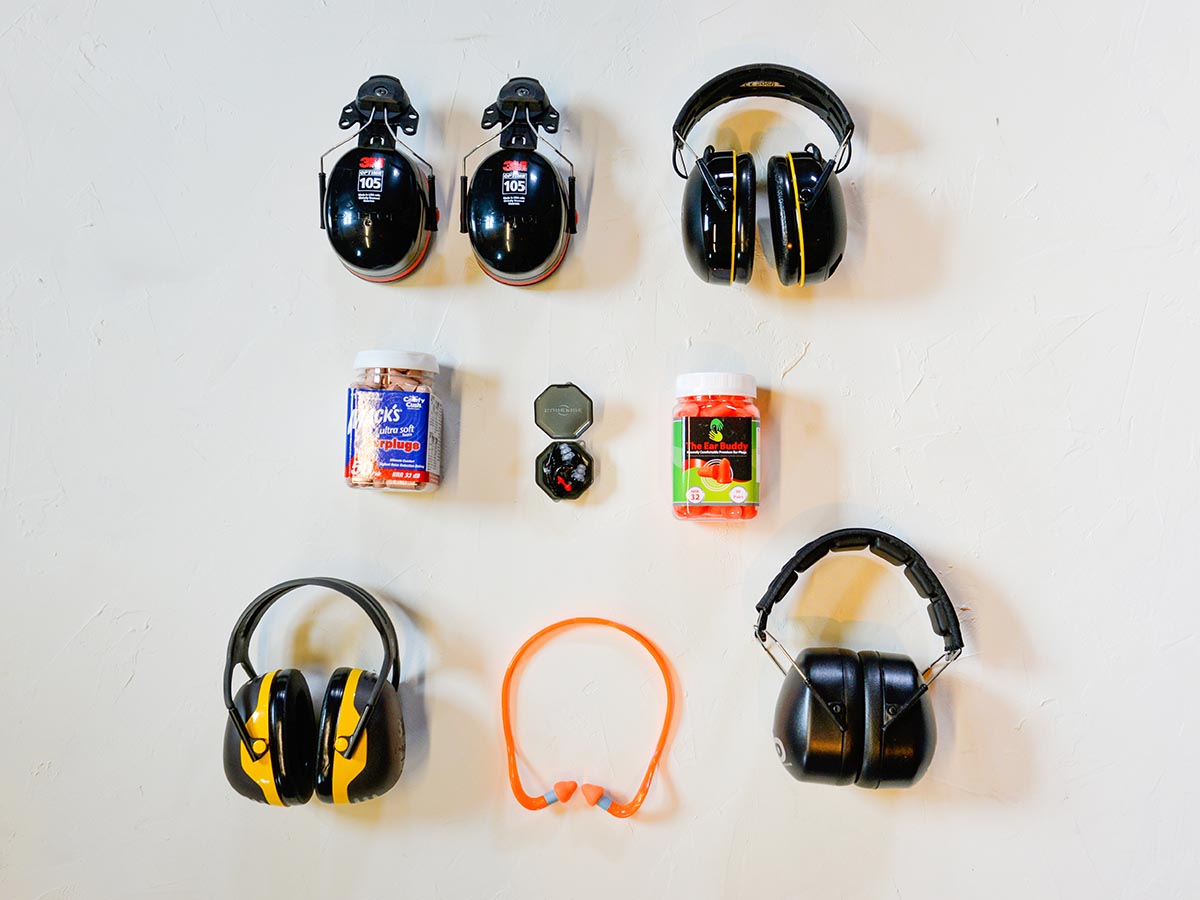
We may earn revenue from the products available on this page and participate in affiliate programs. Learn More ›
If you spend time operating power tools and machinery, you’re undoubtedly making a racket in the process. While most folks know how important it is to protect the eyes, not enough focus goes toward using the best hearing protection to safeguard your ears.
The tools essential for construction, repairs, and maintenance can be tough on the body. Power tools and lawn equipment can wreak havoc on hearing. Loud noises damage the sensitive cells in ears, and eventually, those cells will die. Instead of letting your hearing slip away, wear a pair of quality earmuffs or earplugs when you work.
To find out what hearing protection is truly the best, we vetted and field-tested a variety of products that fit comfortably, perform well in different settings, and won’t break the bank. Whether users prefer lightweight, disposable foam earplugs for outdoor work in hot weather or over-the-ear muffs with Bluetooth connectivity for streaming music and taking phone calls, we have suggestions. Keep reading to learn more about important shopping considerations, the products we tested, and why we consider our picks to be among the best hearing protection available.
- BEST OVERALL: Decibel Defense Safety Earmuff
- BEST BANG FOR THE BUCK: Mack’s Ultra Soft Foam Earplugs
- BEST HEADBAND: 3M Peltor X2 Over-the-Head Earmuffs
- BEST BLUETOOTH: 3M WorkTunes Connect Wireless Hearing Protector
- BEST EARPLUGS: SureFire EP4 Sonic Defenders Plus
- BEST SEMI-INSERT EARPLUGS: Howard Leight by Honeywell Quiet Band Foam Ear Pods
- BEST FOAM EARPLUGS: The Ear Buddy Premium Soft Foam Earplugs
- BEST FOR HARD HATS: 3M Peltor Optime 105 Dielectric Earmuffs
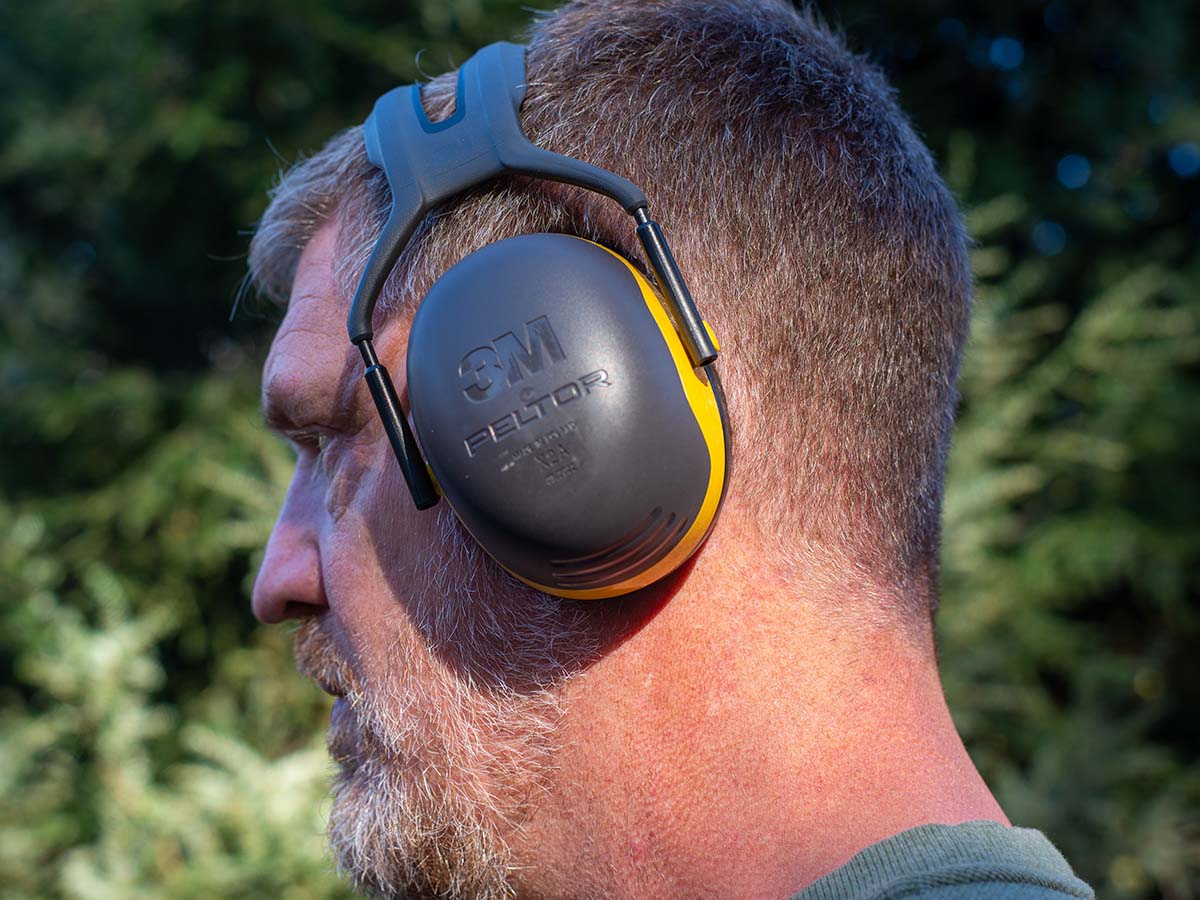
How We Tested the Best Hearing Protection Options
We spent 16 hours researching hearing protection options suitable for use with shop tools and outdoor power equipment. We then built a list of more than 50 products based on workplace standards and recommendations of ANSI, OSHA, and the Centers for Disease Control and Prevention. Finally, we pared the list down to the products in this guide.
Every device on our list was independently lab tested and certified with an NRR value, so we focused two rounds of hearing tests on collecting subjective observations like convenience, comfort, and perceived noise-level reduction as well as durability. First, we donned each set of earmuffs or earplugs in a workshop while working with a table saw, miter saw, and router. Then we moved outdoors and retested while operating a gas-powered riding mower, string trimmer, and backpack leaf blower.
In both rounds of tests, we noted comfort and convenience factors. Some earmuffs were lighter or heavier, allowed for better air circulation, or squeezed the head more or less than the others. Most were less comfortable than earplugs while also wearing safety glasses. Some of the plugs inserted more easily or were easier to keep track of when not in use. We also noted both the loud-noise-blocking ability and the ambient-noise filtering ability. The best hearing protection options balanced an excellent ability to block out loud or sharp sounds but allowed some environmental noise for safe situational awareness, such as opening and closing of doors or approaching vehicles, without removing the device.
Finally, we tested each device for durability. We dropped them off a workbench onto a concrete floor five times each. We also carried each item around in a tool bag with a cordless power tool set for a week. Afterwards, we noted any signs of damage or wear and tear. Other than a few superficial scuffs and scratches, they all passed the durability test in perfect working order.

Our Top Picks
Keeping the practical considerations discussed above in mind, we shopped for the best protective earplugs, semi-insert earplugs, and earmuffs. Then we put them through their paces in a home workshop Since each of these products has been independently lab tested and awarded an NRR rating, our tests focused on functionality, comfort, and convenience. Read on to learn more about how our picks performed in our tests, and why we count them among the best hearing protection options available.
Best Overall
Decibel Defense Safety Earmuff
Pros
- Higher NRR than other earmuffs; provide superior protection in loud environments
- Vented padding in the headband and muffs improves comfort while on the head and when hanging from the neck
- Quality materials and durable construction held up well in our tool box test
Cons
- Foam padding inside the ear cups needed to be realigned prior to use.
Product Specs
- Style: Over the ear
- NRR: 34 dB
- Extra features: Padded headband
Decibel Defense’s Safety Earmuffs are a worthy choice for anyone who needs as much hearing protection as possible yet doesn’t like sticking earplugs into their ears. While few earmuffs can offer more than 31 dBs of hearing protection, the Occupational Safety and Health Administration (OSHA) rates these over-the-ear earmuffs at 34 dB, while the American National Standards Institute (ANSI) certifies them at 37 dB, offering as much protection as many earplugs.
These earmuffs have thick foam padding for closing off the ear, as well as a comfortable headband with six individual pads for ample airflow. The telescoping arms allow for ideal adjustment as well.
During testing, we found the Decibel Defense earmuffs to be very comfortable and effective. They didn’t squeeze excessively, and the deep pads sealed well around the ear. While the NRR claims are excellent, what we liked most about this model was the comfort while wearing them over the ears as well as on the neck when not in active use. Also, the steel wires that attach the muffs to the headband were thicker than the other models, giving these muffs a higher-quality feel. The only issue we had was the foam inside one muff was misaligned, so we had to remove and reinstall it.
Get the Decibel Defense hearing protection at Amazon or Decibel Defense.
Best Bang for the Buck
Mack’s Ultra Soft Foam Earplugs
Pros
- These plugs offer the most comfortable way to achieve an NRR of 33 dB
- Easy-to-use and cost-effective design provides highly effective hearing protection
- Though designed for disposable convenience, the plugs may be reused several times if kept clean
Cons
- The plugs took more than a minute to expand fully in cold weather
Product Specs
- Style: Earplugs
- NRR: 33 dB
- Extra features: None
The 50 foam earplugs in this pack offer superior noise reduction, incomparable comfort, and great value. With an NRR of 33 dB, they’re very effective at blocking loud sounds, and they’re barely noticeable once inserted, so they’re ideal for the workshop as well as wearing for sleep.
The soft foam rolls easily and expands inside of the ear canal and can be reused several times before they start breaking down. For anyone who doubles up their hearing protection with a set of over-the-ear earmuffs, Mack’s earplugs’ soft foam will ensure that their ears stay comfortable while providing remarkable NRR.
It was very cold on the day we tested these earplugs, and in such low temps it took about a minute and a half for them to expand fully in the ear canal. But once they did, we found them to be the most comfortable form of hearing protection in the group. Plus, the pack of 50 makes them an economical choice. We reused our test pairs at least five times and, while we didn’t notice any foam breakdown, we tossed them after that to avoid risking any hygiene problems associated with dirty earplugs. We also doubled them up with earmuffs, which allowed us to judge their comfort and effectiveness in that setting, both of which were great.
Get the Mack’s hearing protection at Amazon or Safeway.
Best Headband
3M Peltor X2 Over-the-Head Earmuffs
Pros
- Lightweight frame has just the right amount of squeeze to stay in place
- Split headband provides excellent ventilation and improved working comfort
- Smooth finish with no unnecessary crevices make it easy to clean
Cons
- Earmuffs did not fold down into the headband, so they’re less compact than other models
Product Specs
- Style: Over the ear
- NRR: 24 dB
- Extra features: None
Those looking for a basic set of headband earmuffs to protect their hearing will want to check out the Peltor X2 Over-the-Head Earmuffs from 3M. These earmuffs offer an NRR of 24 dB, protecting hearing in all but the loudest scenarios.
The open headband uses two separate wires to allow for plenty of airflow, while the plastic cups are lightweight to reduce discomfort. The soft foam ear cushions create a tight seal without discomfort.
We really liked this pair of earmuffs during testing. First, we appreciated the large yellow trim that makes finding them in a crowded tool box a snap. Next, we valued the airy split headband design, as it allows for ventilation and reduces weight. Also, there isn’t any fabric or nooks and crannies for sweat, sawdust, and other funk to collect in, which makes cleaning these muffs very easy. The only downside we noted is that the cups don’t collapse up into the headband like other models do, so they take up more space in a tool box.
Get the 3M Peltor X2 hearing protection at Amazon or JB Tools.
Best Bluetooth
3M WorkTunes Connect Wireless Hearing Protector
Pros
- Boast excellent music and phone sound quality with clear microphone reception
- Extended battery life allows users to keep working all day without recharging
- Deeply padded and ventilated headband offers all-around user comfort
Cons
- Electronic components make these earmuffs noticeably heavier than others reviewed here
- Takes up more storage space because the ear pads do not collapse into the headband
Product Specs
- Style: Over the ear
- NRR: 24 dB
- Extra features: Bluetooth headphones and microphone
Keeping tunes going can be a great way to pass the workday happily. Anyone in the market for a pair of wireless Bluetooth headphones that let the good times roll without letting harmful noises reach their eardrums should check out the 3M WorkTunes Connect earmuffs.
These muffs provide an NRR of 24 dB, which is perfect for most workshop activities and allow for media streaming through a Bluetooth-enabled phone, tablet, or other device. They also have a built-in microphone to enable users to take phone calls without removing their hearing protection—ideal when hands are busy finishing a project on a deadline. The high-fidelity speakers will produce high-quality audio, allowing users to enjoy their favorite songs while working in the shop.
These headphones were our favorite for a number of reasons: The sound quality and microphone clarity proved top-notch. The battery life is also outstanding, lasting more than 30 hours on a full charge. And beyond the music and phone connectivity, the headband is ventilated for comfort.
We have two complaints, however: These earmuffs are heavier than the rest, and they don’t collapse for compact storage. Also be aware that these outstanding earmuffs sound so good, they could totally sweep users away from their surroundings—a potentially dangerous scenario. When working with power tools, we recommend turning the music off and using the muffs solely as hearing protection. Save the tunes for lawn mowing or other zen activities.
Get the 3M WorkTunes hearing protection at Amazon, Ace Hardware, or The Home Depot.
Best Earplugs
SureFire EP4 Sonic Defenders Plus
Pros
- These incredibly lightweight and comfortable plugs provide all-day hearing protection
- Offer 2 levels of protection—one allowing normal conversation and the other offering full protection
- Includes a handy carrying case to protect the plugs from dirt and debris while not in use
Cons
- Attaching the filter flap was uncomfortable while the plug was in the ear
Product Specs
- Style: Earplugs
- NRR: 24 dB
- Extra features: Adjustable filters and neck strap
The EP4 Sonic Defenders Plus are a nice combination of protection, convenience, and comfort. The plugs are made of a soft medical-grade polymer that’s both comfortable and durable to block off the ear canal, creating an NRR of 24 dB. Plus, these plugs have a filter mechanism: a tiny flap that can be opened or closed on the exterior of the ear-canal plug. Opening the flap allows most sound in, while closing it offers the full 24 dB of noise protection.
Users can also maintain a relatively normal conversation when removing the caps without taking the plugs from their ears. This means the earplugs will always be handy, and users needn’t worry about keeping them clean when they take them out. If they are removed during a break, their detachable neckband will keep them in place.
These were some of the most lightweight and comfortable earplugs we tested. They almost felt like they didn’t exist both in the ear and around the neck. In testing, we found that inserting the cover flap made the plugs feel like they were going too deep, so we simply adjusted the flap in hand rather than in ear. Two complementary bonuses worth mentioning: They come with a neck strap and carrying case to keep them clean and close by.
Get the SureFire hearing protection at Amazon or Scheels.
Best Semi-Insert Earplugs
Howard Leight by Honeywell Quiet Band Foam Ear Pods
Pros
- Semi-insert model feels lightweight and comfortable both in the ear and around the neck
- Brightly colored headband and foam caps offer easy visibility
- Pack includes additional plugs for fast, easy replacement when needed
Cons
- Plug angle, squeeze pressure, or fit may not be comfortable for all users
Product Specs
- Style: Semi-insert
- NRR: 25 dB
- Extra features: None
The Quiet Band Foam Ear Pods from Howard Leight by Honeywell are a great option for anyone who likes the protection of an inner earplug but wants the reusability of an over-the-ear system. This canal-cap earplug kit blocks off ear canals with soft foam pods, while the headband keeps them in place, providing an NRR of 25 dB.
To have a conversation, simply pull the plugs out of the ears and rest the headband around the neck. This lets the user chat with others while also keeping the earplugs clean and within easy reach when it’s time to get back to work.
In testing, we found definite benefits to the convenience of semi-insert hearing protection. Not only was the Quiet Band model simple to place in the ears, it was just as easy to remove and store it around the neck to keep it clean. Also great, the kit comes with three headbands, each with an additional set of plugs. Bonus: The bright colors make them easy to locate. The only issue was the headband felt slightly too snug for ideal comfort.
Get the Howard Leight hearing protection at Amazon (3-pack) or Cabela’s.
Best Foam Earplugs
The Ear Buddy Premium Soft Foam Earplugs
Pros
- Highly effective design blocks out most kinds of noise
- Orange color makes these plugs easier for others to see while in use
- Effective and comfortable, whether worn alone or under earmuffs for added protection
Cons
- In colder temperatures, care must be taken so that the plugs don’t fall out while expanding
Product Specs
- Style: Earplugs
- NRR: 32 dB
- Extra features: None
Whether for the workshop or a jobsite, foam earplugs can go a long way toward protecting hearing while keeping a user comfortable. Ear Buddy’s Premium Soft Foam Earplugs do an excellent job of each, offering 32 dB of protection while being lightweight and pleasant to wear.
Like other foam earplugs, the Ear Buddy earplugs compress and roll to allow the user to insert them in their ear. Once they do, they expand and fit the ear canal, sealing out the noise. These plugs come in a pack of 50 pairs, which breaks the per-use cost down to be very affordable.
During our tests, the Ear Buddy earplugs fit nicely and did a good job of blocking out the noise. We also liked that they’re orange, as it makes it easier for other people to see we were wearing them. Under earmuffs, these earplugs remained comfortable and effective. The only issue we found was that cold weather affects how quickly they expand, slowing them down by quite a bit.
Get the Ear Buddy hearing protection at Amazon.
Best for Hard Hats
3M Peltor Optime 105 Dielectric Earmuffs
Pros
- Up-and-down swiveling action while attached to hard hat makes for easy use and standby
- Plastic clips attach securely to most hard hats for convenient jobsite hearing protection
- Deep ear cups provide better hearing protection than most earmuffs
Cons
- The design is not compatible with wide-brim hard hats, and possibly other styles
Product Specs
- Style: Over the ear
- NRR: 27 dB
- Extra features: Hard-hat clips
Due to the bulky headband, traditional earmuffs won’t work when wearing a hard hat—but 3M’s Peltor Optime earmuffs are the solution. This set of earmuffs snaps into the rim of most hard hats, offering protection that works with the PPE.
These earmuffs allow users to protect themselves on the construction site or while felling trees with a crew or at home. The user can swivel the muffs down to protect their ears and swivel them back up and out of the way when they need to hear what’s going on around them. With an NRR of 27 dB, they’re some of the most effective earmuffs on the market.
During testing, it was easy to see the value that these 3M Peltor Optime earmuffs offer. We liked that they swiveled up and down, allowing us to keep a hard hat on while choosing whether or not to wear the muffs. They attach securely, so there’s no concern of them becoming loose or falling off. And while we couldn’t tell the difference between these earmuffs and others with lower ratings, we appreciated the higher NRR value. Our one complaint is that they are not compatible with every hard hat style, such as our wide-brim hard hat.
Get the 3M Peltor Optime hearing protection at Amazon or Staples.
Jump to Our Top Picks
What to Consider When Buying Hearing Protection
It’s great to have a host of options in regard to the best hearing protection for personal needs. When deciding on a set of plugs or muffs, shoppers will want to keep the following factors and features in mind to help them purchase the ideal hearing protection for their workshop.
Types of Hearing Protection
When it comes to protecting workers’ hearing, there’s a variety of products on the market in different styles. Some of these options are more comfortable than others, while some have features, like reusability, that might appeal to eco-conscious consumers. The following are some of the most common types of hearing protection.
Earplugs
The brightly colored dots worn inside workers’ ears are called earplugs. These hearing protection products block the noise by closing off the ear canal completely, significantly reducing the decibel levels experienced by ears.
Plugs are usually made of soft foam, which is rolled between the fingers to compress. Once placed in the ears, they expand and take the shape of the ear canal to prevent excessive noise from entering. These foam plugs can be reused several times but eventually, the foam gets dirty or breaks down from the repeated compressing and should be discarded. Rubber earplugs, which resemble little pine trees in shape, are also available. These plugs are far more reusable but may not offer the level of protection that foam plugs do.
Canal Caps
Those who don’t like pushing plugs into the ear canals may prefer semi-insert earplugs, or canal caps. Instead of rolling and compressing them to fit inside of ears, canal caps use rigid headbands with rubber or foam plugs on the end. The headband creates just enough pressure to clamp the plugs in place over the ears, significantly reducing the exposure to loud noises without inserting a plug deep inside the ear canal.
Canal-cap plugs are generally cone shaped or rounded, providing a proper seal around the entrance of the ear. They can be reused over and over again. They’re great for a home workshop, as it’s easy to take them out of the ears and wear them around the neck while performing quieter tasks and then quickly put them on when firing up a power tool.
Over-the-Ear
Over-the-ear hearing protection works without putting anything inside the ears. Muff-style hearing protection uses rigid headbands to hold hard shells with soft foam pads over ears. They keep abrasive noises from entering by creating a seal around the entire ear.
These muffs do an excellent job of protecting hearing, but the foam can trap heat and the shells can be a bit heavy. They’re indefinitely reusable unless the padding rips or deteriorates. They work well in a shop, but because they can be a little cumbersome, they are less likely to be kept around the neck when not in use. This means locating and putting them on when it’s time to make noise, which isn’t always convenient.
Comfort
If hearing protection isn’t comfortable, it’s less likely to be worn. It’s essential to choose plugs or muffs that are comfortable in the ears and, if applicable, around the neck.
Plenty of people find earplugs to be the most comfortable ear protection. They’re light, soft, and often well suited to wear in warm conditions. Some come with a thin strap so they can be conveniently hung around the neck when not in use.
Canal-cap earplugs are also a comfortable option. The headbands only provide enough pressure to keep the plugs in the ears without creating discomfort. They’re light and easy to wear around the neck when not in the ears.
Over-the-ear-style hearing protection can be a bit clumsy, particularly when worn in combination with safety glasses, but for those with particularly sensitive ears, they may be the only style that feels comfortable. It’s critical to find a pair that fits well but doesn’t create discomfort or cause the wearer to overheat when worn around the neck.
Noise Reduction
A Noise Reduction Rating (NRR) describes how many decibels a particular product lowers noise. For instance, a product with a 30 NRR will reduce a 100-decibel (dB) noise level to 70 dB.
Earplugs tend to have the best NRR. Some offer reductions as much as 33 dB. The most that can be achieved from a set of over-the-ear earmuffs is 31 dB. If both of these styles are combined, an NRR of 36 dB can be created.
Figuring out what level of NRR is needed depends on the work that’s being done. Circular saws run somewhere in the range of 90 dB. To lower this to the accepted safe level of 70 dB and below, hearing protection with a 20 NRR or more will be needed. Here are some popular shop tools and lawn equipment with the typical decibels they create:
- Circular saws: 90 dB
- Miter saw: 102 dB
- Router: 95 dB
- Table saw: 92 dB
- Air compressor: 40 dB to 90 dB
- Gas chainsaw: 110 dB
- Gas lawn mower: 86 dB to 96 dB
- Gas string trimmer: 98 dB to 106 dB
- Gas leaf blower: 95 dB
PPE Compatibility
Personal protective equipment (PPE) is incredibly important for many reasons, but these pieces aren’t always compatible with every type of hearing protection. Folks who wear a respirator or goggles while working should ensure that their ear protection will not interfere with the PPE.
Earplugs are fairly universal, working with all PPE. Semi-insert plugs are slightly more of a challenge, as the headband could tangle with a respirator’s straps or safety glasses.
Over-the-ear earmuffs are the biggest challenge. They may not work with a respirator, mostly due to the neck straps and the harness. Also, safety glasses that need to tuck underneath the muffs will create space for noise to sneak through, reducing the effective NRR rating of the muffs.
Temperature and Humidity
Temperature and humidity have less to do with effectiveness and everything to do with comfort. Due to the nature of hearing protection products, they aren’t breathable and can trap body heat. This isn’t an issue with earplugs or semi-insert plugs, but it’s a major concern with over-the-ear earmuffs.
Over-the-ear earmuffs trap lots of body heat, both in the shell and the headband (especially when worn around the neck). The thick foam and airtight coating don’t allow the muffs to breathe, which can be particularly uncomfortable in non-air-conditioned spaces like workshops or garages. Consider using earplugs to stay cool and comfortable in these types of spaces.
Communication and Audibility
While the ability to hear the surroundings may seem strange in an article about hearing protection, situational awareness is equally essential to staying safe in a work environment. If working with other folks nearby, being able to hear and understand them can help increase workflow and keep everyone safe.
If this is important, check into electronic hearing protection that detects and blocks dangerous decibel levels while still allowing the user to hear normal conversation and safe noises. These electronic plugs cost more than standard options, but they make a huge difference when working around others.
Bluetooth
Listening to music can increase workflow and help some people to focus on the task at hand. It can be challenging to hear a stereo through earplugs, of course—which is where a Bluetooth-enabled set of earplugs or muffs may come in.
With Bluetooth hearing protection, users can tune into a favorite music app while also protecting their hearing from excessive noise levels. The same considerations apply as standard hearing protection, however, so these earplugs or muffs need to be comfortable and compatible with PPE.
Additional Features
There are a few other things shoppers might want to look for when searching for the best hearing protection. When it comes to earplugs, some may prefer those that hang from a soft neck cord. They might also consider the material the hearing protection is made of. They may choose from inexpensive, compressible foam ear plugs or longer-lasting silicone, rubber, or plastic types. For the best combination of ear fit, sound quality, and long working life, some shoppers choose to pay a premium for custom-molded ear plugs.
Concerning earmuffs, something lightweight that won’t hang uncomfortably from the neck may be a priority. In hot weather, sweat-wicking ear pads improve user comfort. Low-profile earmuffs offer improved comfort, while deeper models may offer greater noise protection. Some feature electronic noise-canceling features to protect against impulse noises that are common on construction sites or shooting ranges. For work environments where hard hats are required, choose ear muffs that attach to the hard hat.
The Advantages of Owning the Best Hearing Protection
It’s all too easy to damage hearing. In fact, a single exposure to a loud noise can cause permanent damage. Imagine what long-term repeated exposure to noisy power tools can do. Owning and using the best hearing protection helps prevent hearing loss due to immediate and accumulated exposure.
Hearing protection that’s comfortable for one person may not feel great on someone else. Shoppers who purchase the best hearing protection for their personal needs will ensure that they use it instead of taking the plugs out or muffs off and setting them aside. After all, they won’t do any good sitting on a workbench.
If an employer requires hearing protection, workers will want to ensure that they have the best hearing protection possible instead of just using what their employers’ provide. Employers may offer inexpensive PPE to meet particular insurance or OSHA requirements, which may be inferior to a high-end product. Workers buying their own comfortable, reliable hearing protection lets them avoid the pitfalls of lesser options.
- Protect hearing from years of damage.
- Choose the perfect fit for an individual’s comfort needs.
- Use high-quality hearing protection.
FAQs
There’s a lot riding on your choice of the best hearing protection, so if you still want more information, consider the answers to these common questions about these products.
Q. What is the best noise-reduction rating?
One of the best hearing protection products regarding NRR are earplugs. They provide up to 33 dB of noise reduction. If you double them with an over-the-ear earmuff with an NRR of 31 (the maximum available), you can obtain a combination NRR of 36 dB.
Q. What is a dangerous decibel level?
The widely accepted safe decibel level is anything less than 70 dB. Above 70 dB, you should consider wearing hearing protection to lower your chances of damaging your hearing.
Q. Which is better: in-ear or over-the-ear protection?
In-ear hearing protection does a better job of reducing noise, but over-the-ear protection is better than nothing. It’s largely dependent on what you’re comfortable with and what you’ll use. It doesn’t matter if in-ear plugs are better if you’re too uncomfortable to shove them in your ears.


